Focusing on your dental office front desk duties, tasks and routines is the single most important thing you can do to help you run a smoother operation.
If you’ve ever felt like you’re just going through the motions on a daily basis in your practice- You know – where you feel like your days just go by and you have NO control over what’s going on.
Which typically turns into you NOT enjoying what you do on patients.
Which THEN ultimately affects your income – which may be inconsistent from month to month.
Well, I’ve been there and there are still few days out of the year I feel the same.
In this video that’s exactly what I want to share with you – the things I’ve done to get control back while I’m in the office.
Make sure to stick around because I’m going to get into the actual routines I follow in the office to give me control over my day and ultimately my finances!
Download the Front Desk Duties Checklist and Routines pdf
There are days or maybe you feel like this every day because I know I used to – where you’re kind of just going through the fast lane on the highway and running into things as they come along.
Leaving you at the end of day feeling EXHAUSTED and glad it’s over.
And and now you’ll do it all over again tomorrow.
Wake up, make coffee/tea, maybe exercise if you’ve got the time.
Rush to get ready to go to the office and you’ve got patients lined up for you.
Maybe there are team issues.
Maybe someone has called out so you’re short staffed.
The lab hasn’t returned a case for a patient coming in for an insert, and no one followed up on it.
The patient coming in today has a balance from four months ago because insurance paid less than what you expected.
And now, it’s the end of day – and you’re exhausted!
But your day hasn’t ended yet.
Now you’ve got to sit down with your manager or maybe your front desk and go over all the exciting things like –
- production,
- collection,
- why the two patients cancelled and no showed on you today,
- why there are holes in the schedule tomorrow,
- why you’re not scheduled to goal next week when you’ve got a big list of patients with pending treatment.
But you just want to head home after a long day.
It feels like it’s never ending.
You have no control. You’re constantly putting out fires and you literally feel like you’re just showing up to get some cash in the bank for this month – so your bills are paid this month.
And hopefully, if you’ve got some left over, you pay yourself.
I felt like this for a long time until I decided to take control and slow down.
Don’t get me wrong. I’m not perfect. There are days that still feel chaotic.
I still put out some unexpected fires.
But it’s no where close to what it was in the first five years in my office when I started back in 2013.
If you’ve read my newsletters, or watched videos, or read through my posts, you know that I talk about routines quite a bit.
Because of the routines, and most importantly, the consistency –
- I’ve been able to cut back on my clinical days to two days a week for the last year and a half with no associates or hygienists.
- I do procedures I like and still accept PPOs
- I take home a pay that I’m happy with because it lets me pay my bills, which isn’t a lot compared to what I’m bringing in since I have no personal debt.
- It allows me to re-invest cashflow back into the office
- And the time I’m not spending at the office during the week – I’m able to invest that time building my software company
- The monthly cashflow from the office allows me to invest consistently into retirement accounts, active trading accounts, crypto, and then also some for me to splurge on things I like – like buying gadgets, and traveling with family.
I can do a whole separate video on the routine stuff when it come to non-office stuff.
I’ve gone through a lot of different apps / paper note books to track things – trying to do a whole lot and then not being able to accomplish everything that I wanted to start doing – and then feeling like crap.
So it’s an ongoing struggle, but I’ve gotten better.
You’ll reach a certain point in your life where you have routines that you follow without having to think about it.
Some, you’re already doing because it’s become so ingrained into your daily habits – like brushing your teeth.
For me, I wake up, brush my teeth, and I drink warm lemon water with turmeric, black pepper and salt.
Over time I added and removed things from the routine and adjusted to whatever is going on in my life at that time.
I used to workout in the morning at 6 AM, but now I have a 3 year old and a 10 month old – I changed the timing to where the workout happens in the afternoon during their naps.
I used to eat breakfast everyday, but I’ve lately introduced intermittent fasting 2-3 times a week, so those days I skip breakfast – and don’t have my first meal until 12 pm when I’m in the office for lunch.
Following this pattern is super boring, but because I’ve been doing it for so long – I don’t even think about doing it, I just do it.
In the beginning when I was getting started, it was tough – but once I started to see results – I kept going.
I rarely get sick, I can run faster and longer than i did back in undergrad, I can lift heavier than I did in my twenties.
Routines in my personal life has allowed me to fight many personal battles prior to this point.
These good routines and habits have spilled over to my practice as well.
It’s an amazing domino effect – once you start to workout consistently, you become conscious of what you’re eating, so you eat less crap and then you become leaner.
This phenomenon is sometimes referred to as habit stacking – which James Clear refers to in his book Atomic Habits.
I have NOT finished reading it fully, but it’s a great book so far and it’s a must read.
Front Desk Duties and Tasks
In my dental practice, it’s no different than it is in my personal life.
You’re just doing different activities – but the same habit stacking concept applies.
There are routines that I’ve established WITH my team – both for administrative side as well as the clinical side.
For instance, if we just look at the administrative side – if we do all the things that are supposed to be done on a daily basis, we will have less work to do on the weekly routines, and then the monthly routines, and so on.
And the opposite is also true – if you skip things you’re supposed to do on a daily basis – the work piles up, the errors add up to your weekly tasks and then to monthly tasks, etc.
To give you an example, if on a daily basis, we DON’T check if correct procedures are attached to a patient’s appointment, and their insurance is properly verified and attached to their chart correctly – when the claims are sent – claims will come back with reimbursement that is different than what we expect.
Majority of the times, it will be less than what you expect, and now you’re stuck with trying to collect balance from the patient.
If on a daily basis we don’t check for rejected claims (claims kicked back due to incorrect info, terminated plans, etc.) – our weekly routine of checking outstanding claims will have more claims to follow-up on – increasing the amount of work that your team has to do, which could’ve been eliminated from the get go.
So if we do all the work upfront that’s supposed to be done, your weekly and monthly routines will take a lot less time and save your team’s valuable time (which you’re paying for).
To give you an idea of what our routines look like, I’ve included a downloadable pdf, which is linked at the bottom of this video.
Please use it as reference and modify as you wish in a way that works for your practice.
Routines without consistency are pointless.
I don’t have an employee handbook that my team references.
You don’t have to get fancy. This could literally be on a piece of paper printed up in large fonts, so your team can reference it EVERYDAY – it becomes the office bible.
In order to get the most done for the time you’re working in your office, there must be systems in place that makes it super easy for your team to accomplish what they need to do.
So before getting into it – here’s a bigger picture of how I like to think of all this:
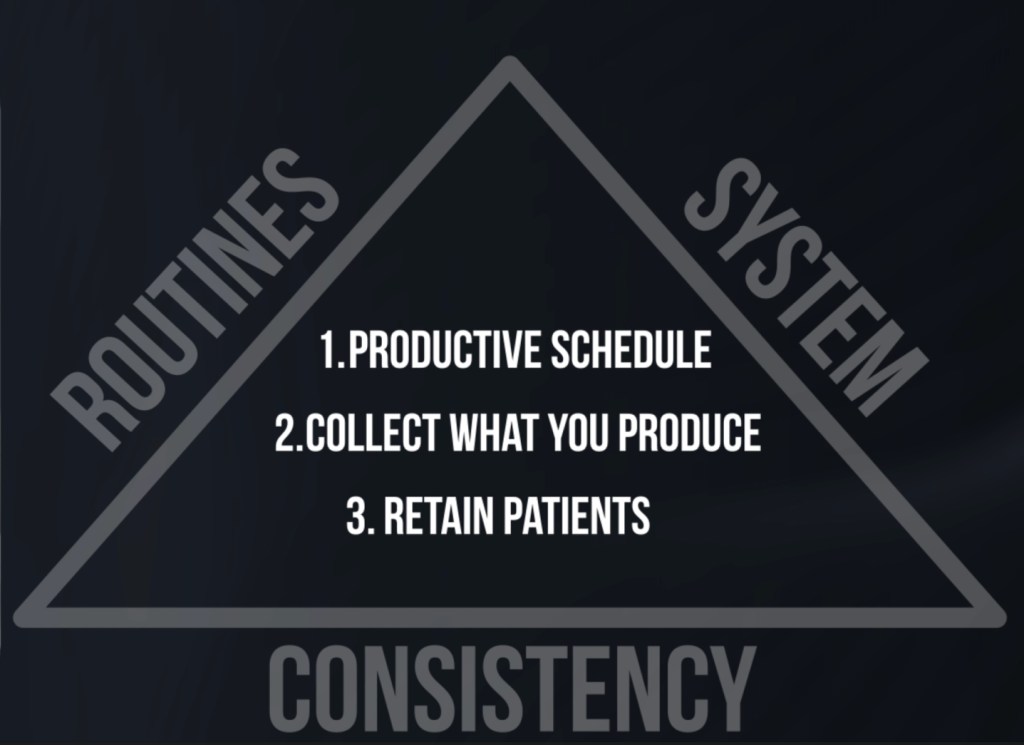
Routines are activities that must be done to accomplish a certain goal.
A system is basically going to define step-by-step process how to start and complete that activity – and it should be assigned to a team member.
And most importantly – consistency, is achieved by following a pre-set time and frequency – for instance: every Wednesday, or once a month, or daily, etc.
You may go a step further and also indicate the time ( I call it time blocking) – every Wednesday at 1 pm, outstanding claim calls to insurance companies should be completed – for example.
You, as the doctor are busy seeing patients – but there has to be routines that your team must follow to make sure three goals are met:
- Productive Schedule (so you and or other providers – your hygienists and associates can produce)
- Collect what you produce – if you’re not collecting what you’re producing – you’re working for free and leaving $$$ on the table.
- Patient Retention – not everyone comes back every six months for their cleaning – some may only return for emergencies, but in order for you to to sustain your practice and keep up with your fixed and variable expenses – you have to retain a percentage of patients to keep you busy.
This is my version of how I’ve implemented this in my practice.
Any activity that’s done in the practice – supports either one of these three goals.
Let’s look at an example:
- Team training – Training my team on how to handle objections or questions from patients regarding making payments at time of service – this is the routine or the activity.
- System: Where is my team accessing this information? Is it digital? Can they easily access it? or is it written down on a printed manual that goes over step by step how to perform the activity?
- I may spend 2 hours a month on training my front desk personnel going over how to perform this activity (this is my consistency schedule)
But this whole routine (which is going over how to handle objections / questions from patients for payments) – is going to help me COLLECT WHAT I PRODUCE – which is one of the three goals I mentioned.
The PDF that you’ll be able to download – indicates the routine, the schedule, and it indicates which goal it’s helping me accomplish.
Let’s look at an example routine I have on the PDF.
Let’s look at the first goal:
Productive Schedule for your Dental practice
One of the things we do on a daily and weekly basis is have my front desk follow-up with patients for pending treatment.
Whether it’s their first time reaching out to the patient after having something treatment planned for the patient – or whether it’s their 2nd, 3rd, 4th, or 5th attempt reaching out to the patient –
We make sure that unless the patient asks you specifically not to reach out – we reach out to patients.
For instance – with Teamio, I’m able to see who they’ve reached out to whether it’s today, weekly, or monthly – and who’s actually getting scheduled from the follow-ups.
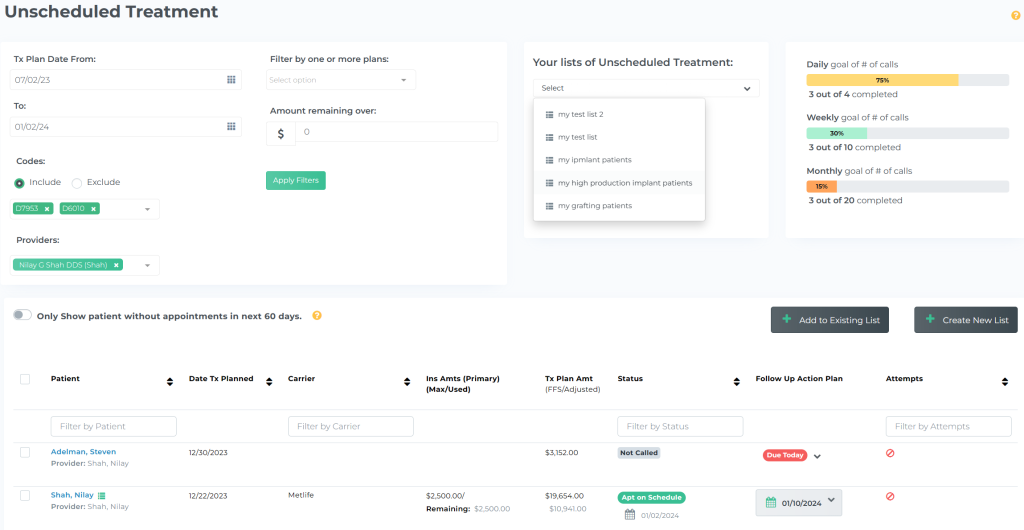
If your team makes one phone call to follow-up with the patient and the patient doesn’t pick up – there’s high chance that patient is never called again and it falls through the cracks until the patient comes back for their next recall.
So you need an easy system for your team to know who’s to be called when for a follow-up or who’s NOT to be followed up with.
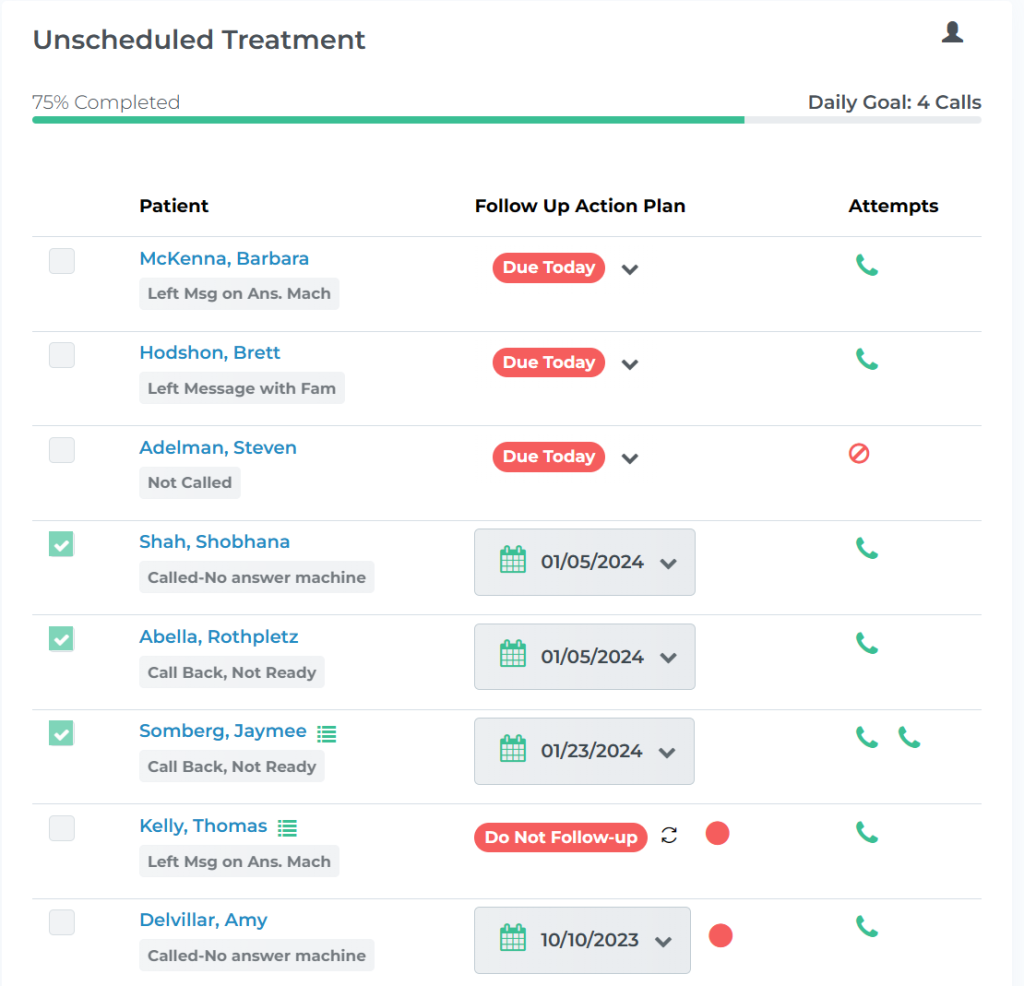
Doing this consistently, you not only keep your data clean with clean patient lists – but you will consistently fill your schedule.
You will always have patients in the “pipeline” to reach out to for pending work.
I’ve talked to hundreds of team members after doing demos and training office owners, team members, managers – and I can tell you following up for pending treatment creates this sense of “being too salesy”.
Instead of thinking you’re being pushy or salesy – think of it as service to your patients.
It’s a mind set shift from thinking “I may annoy this patient for leaving this voicemail for the second time”.
What you’re really doing is providing a service to your patients by reminding them to schedule an appointment for pending work before it turns into something bigger and more serious.
Following up is a topic that I could go on to discuss for a whole separate video by itself – so I won’t get into details here.
Let’s move forward.
Tracking Scheduled Production
Another thing we do is we track our scheduled production and make sure I’m scheduled to goal for the upcoming weeks.
I don’t care to look at next month – we all know that most patients schedule can change from day to day.
So we typically look at the next two weeks because we know majority of the patients will keep their appointments.
Using Teamio’s Scheduled Production analytics on Huddle, it provides an easy way for my scheduling coordinator to know with a quick glance if we’re scheduled to goals.
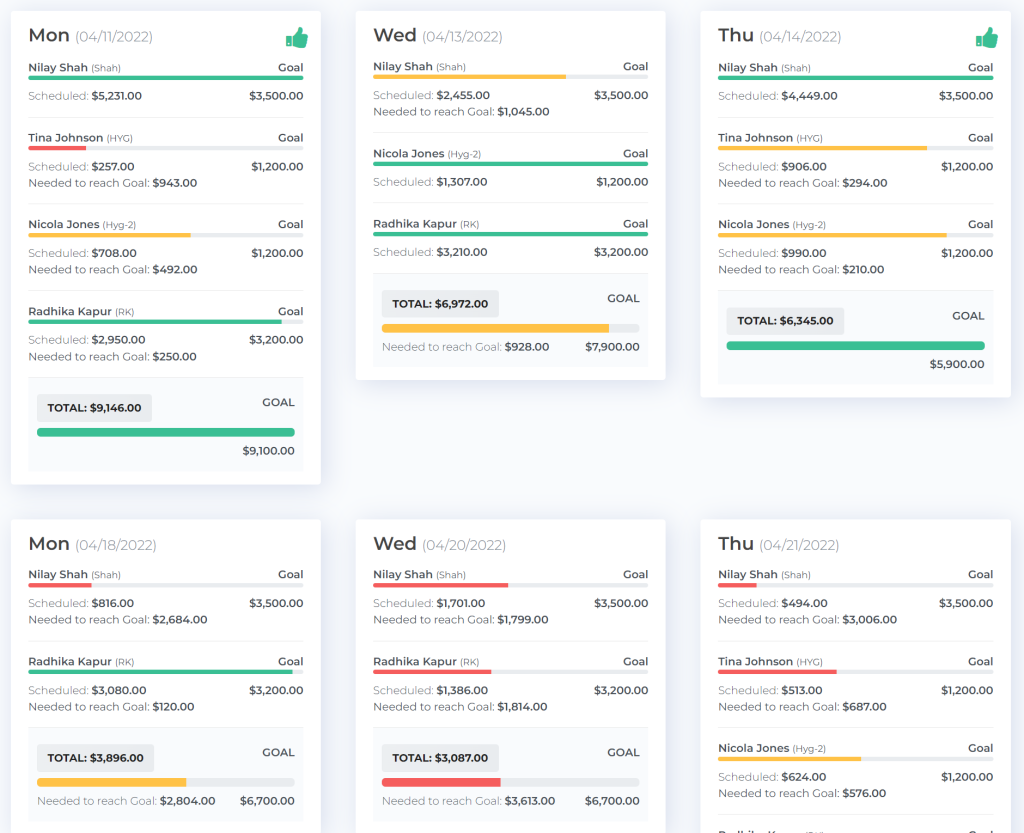
Let’s move forward with the second goal.
Goal #2: Collecting what you produce
Attaching supporting documentation / narratives
Since you’ll need to communicate with the team member who’s uploading narratives / charts, etc. – they should be working with templates and have an easy way to communicate back and forth for things they need.
If you’re an office that’s outsourcing your insurance – you still need a way for your team (including the doctors) to communicate with the outsourced company who may be handling your outstanding claims.
If they need a specific narrative from the doctor for moving ahead with processing of a claim – or maybe they need to tell you that the patient needs to call their insurance company for further processing of the claim – you’ll need a way – whether it’s through email, some chat, or whatever it may be – and be able to track all forms of communication back to that claim.
In my practice, it’s the combination of Teamio’s outstanding claims follow-ups and activities for each claim.
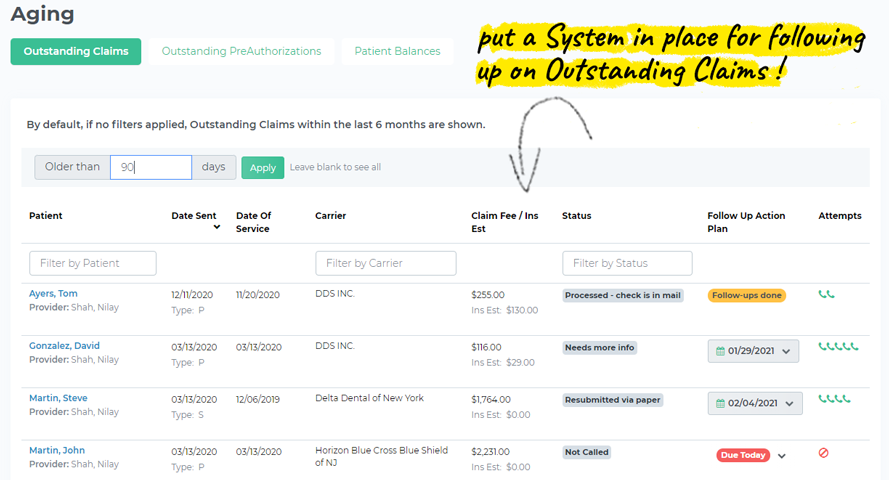
We then utilize Teamio Tasks where we can call out or tag a specific team member and / or a patient – and communicate back and forth via comments.
When I train offices, and if they’re using an outsourcing company for insurance – I recommend actually setting up a chat group in Teamio Chat.
In the chat group, it’s the dental office personnel who may be responsible for dealing with claims, and team members from the outsourcing company.
This way, only those individuals part of the chat group can see all the messages regarding patient claims, etc. because your hygienists, associates, or assistants don’ t have to be part of that group.
Now there’s one place to chat quickly regarding claims from any place in your office or even remotely.
Patient Balances
Another thing we do to make sure we collect what we produce – is keep an eye on patient balances.
Yes, it’s part of AR – by definition it means accounts receivables – meaning money owed to your practice.
This can be either 3rd party (insurance company, financing company) or from patients.
So keeping an eye on patient balances AFTER the claim is received is super critical.
The easiest way to not have any balance – is to collect the patient portion at the time of service.
For a fee-for-service practice – you simply collect on the day you start work. You may even be collecting a deposit.
And if you’re splitting payments into multiple visits, for instance – maybe patient paid only 75% on the crown preparation visit.
Whatever they didn’t pay stays on account and you simply collect the rest on crown insert visit.
For insurance patients, assuming you’ve verified benefits and properly attached to their chart – on preparation visit you collect their estimated out of pocket in full.
Then, whenever that claim payment comes in – the claim payment + out of pocket payment you collected should equal the in-network fee or the insurance allowable fee for the procedure you did or billed to the insurance.
This is all assuming insurance pays as expected.
What if the claim payment is less than what you expected? – because you didn’t take into account the fact that cigna downgraded your ceramic / PFM crown to a stainless steel crown (D2790).
Now the claim payment plus the patient out of pocket is less than the full fee of the procedure you actually billed or completed – which means patient should now have a balance.
And YOU need a way to track that balance, so you can collect on it.
Simplest way is to avoid this all together from happening.
By assuming downgrades for everything when you collect copays, may mean that you’re slightly over collecting from patients
But it’s better to have credits on the accounts than balances.
It’s always harder to ask for money than to refund.
In my office, we have a list where we can easily see patient balances (after claim is generated) – so we know this is true patient balance or money they owe.
If they have a balance, we know we need to follow-up on it.
From that point, we take the right action by putting that patient into our follow-up cycle – which is phone calls, sending out statements, etc – and then after certain attempts – dropping them into collections.
Whether you decide with your insurance coordinator – or your manager – you need a way to know who needs follow-ups and what’s happening with those patients, when they need to be contacted again or statement sent, etc.
There are other routines to make sure you’re collecting what you produce.
Attaching correct procedures to dental appointments & claims
Attaching correct procedures to appointments and then to claims before you mark the appointment completed during patient check-out is the first step to making sure you’re billing what you produce.
If, for instance, you’re taking certain number of x-rays during a hygiene visit – you have to make sure the right number of x-rays are attached to the appointment with proper codes.
For example, if you’re taking multiple PAs, first PA goes in as the First PA code and then the additional ones go in as separate codes.
As simple as it sounds, the number of times this is looked over – is costing you on a daily basis!
Checking Claim Submission Portal
Checking your claim submission portal to see if any claims are kicked back due to incorrect patient IDs, or other information should be done on a daily basis.
In my office, I use DentalXchange. But regardless of which system you use, this is an important step so you can correct whatever it is that is causing the claim to be rejected before the insurance company even starts to process it.
Sometimes it’s rejected because the patient is not found on their system. That usually means the patient’s insurance changed – they forgot to tell you about it or maybe completely unaware of it.
Goal #3: Patient Retention
The third goal that’s important to a growing practice is patient retention.
Of course, you need new patients, but if they’re only coming to see you once and the rest are leaving the back door – and you have no way of knowing whether or not this is actually happening – you’re leaving a lot of money on the table.
If you’re spending on marketing – your cost per acquiring each new patient is super high because the lifetime value of the patient is significantly lower since the patients aren’t sticking around.
And this is why your hygiene – the recall department is super critical!
If you have one or more hygienists in your practice – we’re all aware that their payroll costs have shot through the roof.
So, keeping them productive means having a strong recall program.
Pipeline of patients overdue for Recall
In addition, your team needs easy access to a list of patients who don’t have their next recall visit scheduled so they can reach out to them or can be texted automatically in the background on each day the patient is due.
Again, if done consistently, you’ll reduce the holes in the hygiene schedule – keeping the hygienists busy.
If your hygienists are busy, you’ll also build the doctor schedule also,
Quick Summary
Having written down front office duties checklist and routines is important – but it’s more important to follow-through with them.
Whatever system you decide to use whether it’s on a piece of paper, excel sheet, or you do it on Teamio – it’s important that you and your team have a visual of
- what needs to be done
- when it needs to be done by
- how often it needs to be done
- knowing whether or not it’s actually completed
- and most importantly, all of this is done on a consistent basis
You can’t just do something for a week, or two weeks, or just for the first month – and expect results.
And also remember, this doesn’t have to be set in stone, you may implement new ways of doing things as you move forward, as you get busier.
So, you’re going to be constantly tweaking your systems and have them written out, so everyone involved in the process is on the same page.